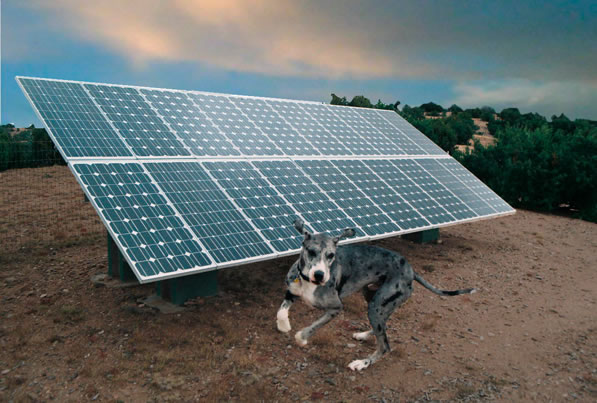The Scene
In a region where Native Americans have lived at the mercy of the environment for centuries, modern-day homeowners can take advantage of readily available and ample natural resources to create self-sustaining homes. Desert Shadow, a home currently under construction near Santa Fe, New Mexico, will achieve this goal.
Nestled in rolling hills dotted with pinyon juniper and little else, the Allegretti Architects-designed residence is located about 40 minutes south of Santa Fe and occupies an isolated 40-acre plot roughly 7,000 feet above sea level. The site currently houses a yurt, in which Desert Shadow’s owners have lived for the past five years. The owners have decided to upgrade to a more permanent structure, but they’re not sacrificing their commitment to minimal environmental disruption in the process.
The Setup
Although Desert Shadow’s owners made a conscious choice to incorporate a multitude of sustainable features into their home, the building’s location dictated that it be completely self-reliant. The nearest power line is two miles away, and the home does not have access to any public utilities. “The location is quite remote,” firm principal Greg Allegretti says.
The terrain heavily influenced Desert Shadow’s orientation. North-facing views that highlight the scenic mountains of Taos are typically desirable in Santa Fe-area homes. With its northern face built into the hillside, Desert Shadow bucks this trend, allowing the home to capitalize on the plentiful sunshine available to the south.
The Strategy
 In order for Desert Shadow to fulfill all of its own energy needs, Allegretti’s design includes a number of features that maximize available natural resources. Unsurprisingly, solar energy takes center stage. With hundreds of days of sunny weather each year, New Mexico is a prime location for solar-powered homes, but Allegretti says that the region is underachieving in that realm. “We don’t realize our solar potential here,” he says. But Desert Shadow will serve as a shining example in that respect, using 20 photovoltaic panels, each of which is capable of collecting 250 watts of power. A high-capacity storage battery and an AC inverter enhance the setup, and an LED system replaces traditional lighting, cutting down on the use of electricity. In addition to generating power, the sun serves as an important source of Desert Shadow’s heat. By facing south, the home’s passive solar orientation helps to maintain the structure’s consistently comfortable temperature. Desert Shadow also features radiant heat in the floor and a wood stove that is a secondary source of heat.
In order for Desert Shadow to fulfill all of its own energy needs, Allegretti’s design includes a number of features that maximize available natural resources. Unsurprisingly, solar energy takes center stage. With hundreds of days of sunny weather each year, New Mexico is a prime location for solar-powered homes, but Allegretti says that the region is underachieving in that realm. “We don’t realize our solar potential here,” he says. But Desert Shadow will serve as a shining example in that respect, using 20 photovoltaic panels, each of which is capable of collecting 250 watts of power. A high-capacity storage battery and an AC inverter enhance the setup, and an LED system replaces traditional lighting, cutting down on the use of electricity. In addition to generating power, the sun serves as an important source of Desert Shadow’s heat. By facing south, the home’s passive solar orientation helps to maintain the structure’s consistently comfortable temperature. Desert Shadow also features radiant heat in the floor and a wood stove that is a secondary source of heat.
Daily temperature swings of 30 degrees or more are not unheard of in the area, so Desert Shadow needed to be able to capture the heat generated during the day and use it at night. The home features thick cellulose insulation, and its design eliminates thermal bypass in corners where an interior wall intersects with an exterior wall. Triple-glazed windows with an extra storm panel also help to maintain a consistent internal temperature.
As is expected in an arid climate, water is also a significant concern for Desert Shadow. The home’s rainwater-harvesting system collects water for landscape maintenance, and that landscape includes materials and plants that require minimal irrigation. The site is also graded to reduce runoff. A deep well that taps into the natural spring hundreds of feet below the ground provides a source of potable water.
Desert Shadow’s focus on sustainability goes beyond its reliance on natural resources. The project relied predominantly on locally sourced materials available from within a 100-mile radius. Its advanced framing techniques required less wood, and all of the wood used was unfinished. In addition to his work for clients such as Desert Shadow’s owners, Allegretti designed his own sustainable home, where he has lived for 20 years. “I put my money where my mouth is,” he says.

